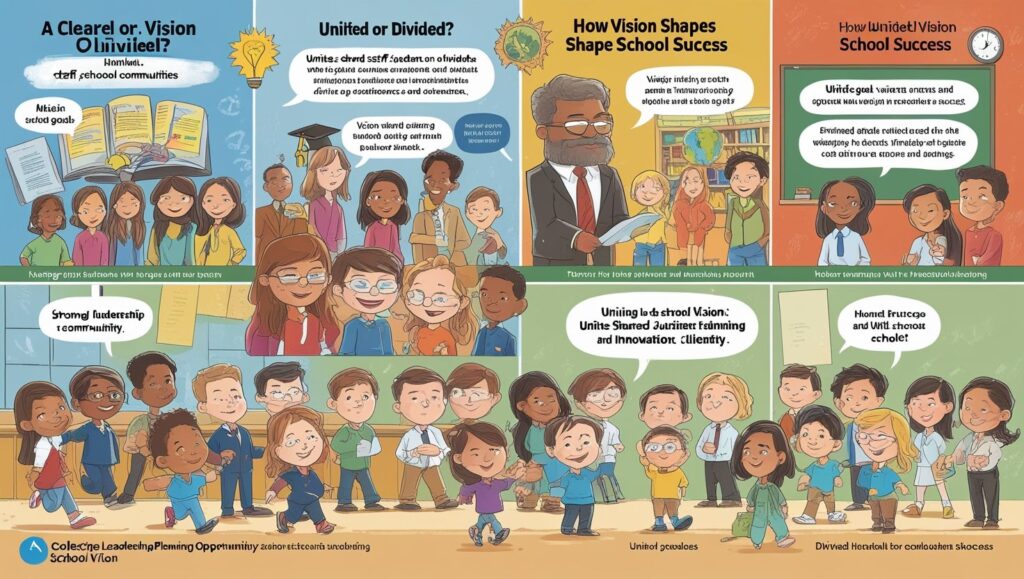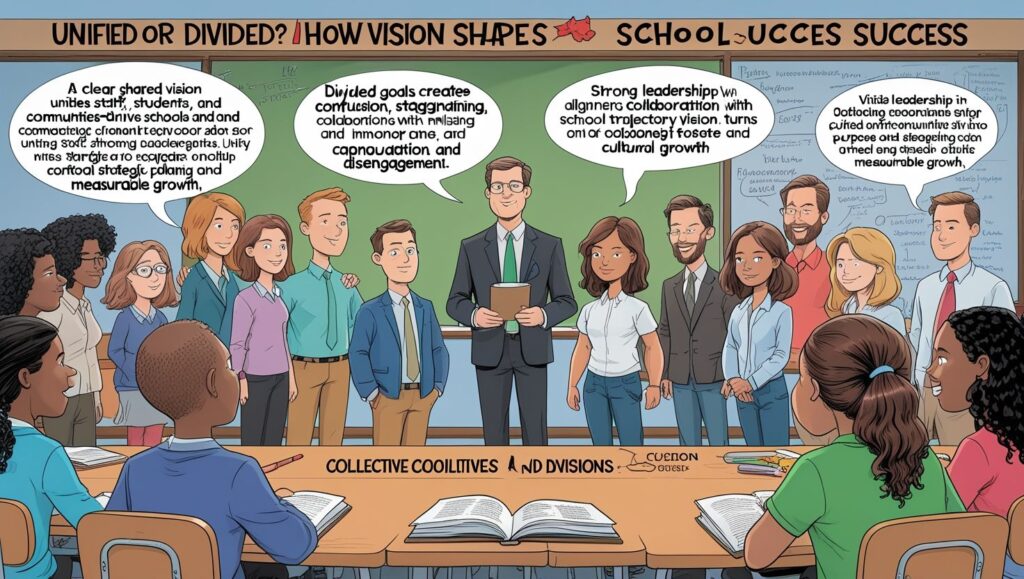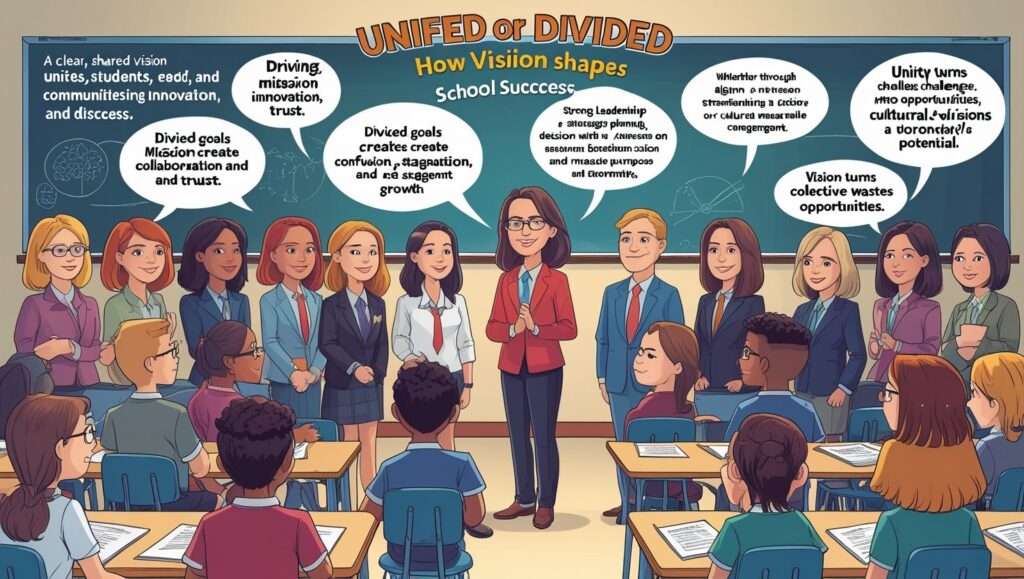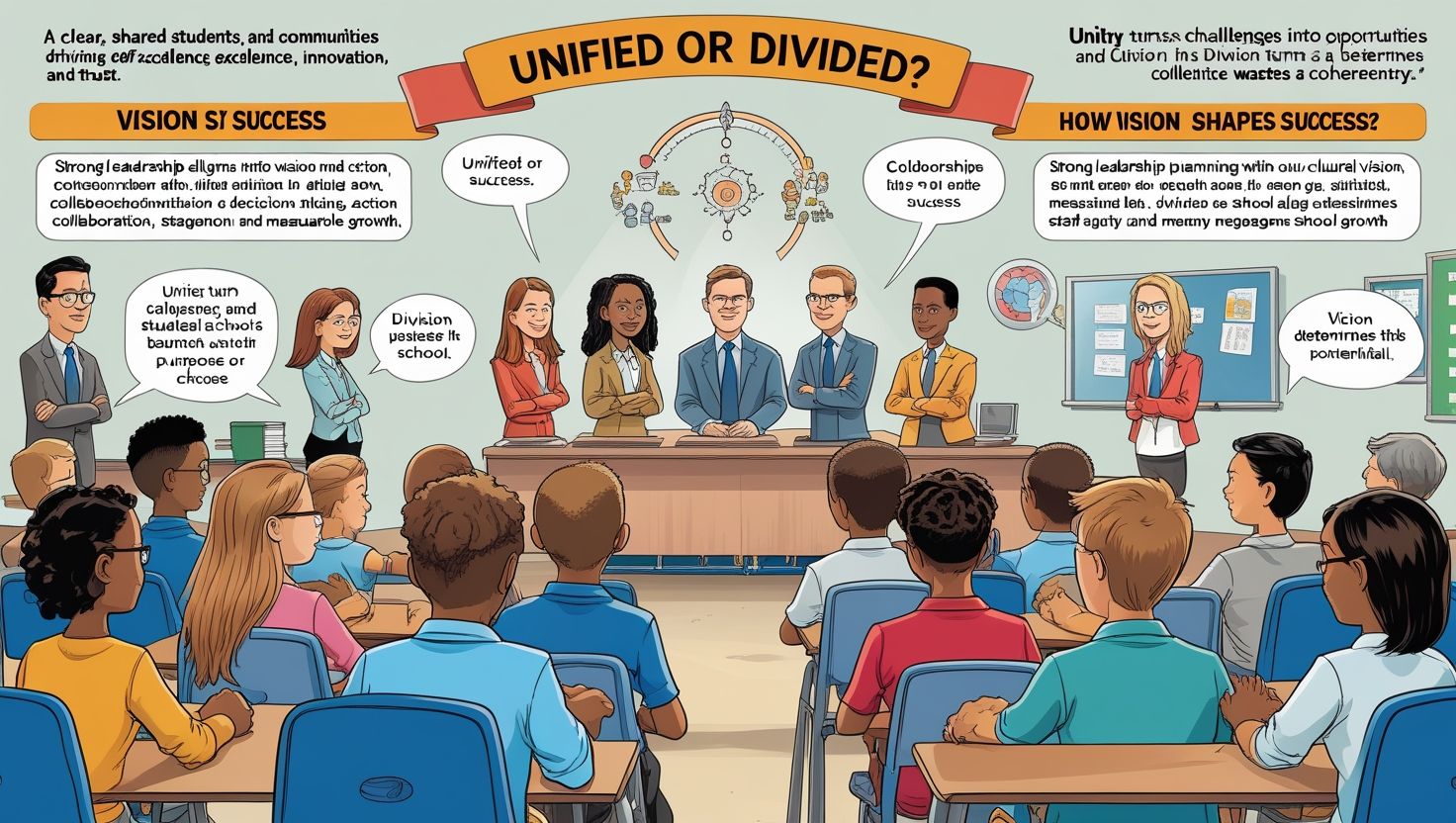Introduction:
Unified or Divided? How Vision Shapes School Success, Vision plays a crucial role in shaping the culture and outcomes of educational institutions. When schools adopt a unified vision, all stakeholders—teachers, students, administrators, and parents—move in a synchronized direction. However, when visions diverge, confusion and inconsistency often emerge. As a result, the academic and moral fabric of a school weakens. While some may argue that diverse visions encourage innovation, the lack of coordination can hinder overall progress.
Clearly, a shared vision provides coherence and clarity. It aligns goals, guides planning, and sets expectations. On the other hand, when different visions dominate, conflict may rise between departments, staff, or even between administration and teachers. Consequently, academic goals can become blurred. Therefore, understanding the differences between a same vision versus a different vision in a school context is essential. It not only helps explain academic trends but also highlights the need for unity in purpose. In this article, we explore how both scenarios influence school outcomes, culture, staff performance, and student learning.
Shared Vision: A Path to Unified Progress
A shared vision is the foundation of a successful school. When all stakeholders operate under a unified purpose, progress becomes not only achievable but also sustainable. First and foremost, a common vision provides clarity. Teachers understand what is expected. Students know the academic standards. Parents become informed partners. As a result, everyone contributes meaningfully toward the same goals. Moreover, shared vision fosters team spirit. For instance, collaboration becomes smoother since staff members trust and support one another.
In addition, decision-making is more aligned with long-term objectives. Even during challenging times, such as reforms or crises, a shared vision keeps everyone focused. Furthermore, instructional strategies and assessments are streamlined. With this, students experience consistency in teaching methods and academic expectations. Besides, professional development for teachers is targeted effectively. Overall, a same vision fosters academic growth, promotes positive behavior, and builds a strong learning community. Thus, it is evident that unity of purpose directly correlates with school success and lasting results.

Divergent Visions: A Recipe for Confusion
In contrast, when schools operate under multiple or conflicting visions, confusion often follows. While diversity of thought is important, a lack of common direction may lead to disjointed efforts. For example, one group of teachers may focus on rote learning, while another emphasizes creativity. As a result, students receive mixed messages about what is valued. Consequently, academic outcomes become inconsistent. Moreover, policy implementation suffers. When staff do not share the same understanding, communication breaks down. In many cases, departments compete rather than collaborate. Additionally, school leadership faces difficulty in setting and evaluating goals.
Without unity, measuring progress becomes challenging. Furthermore, the morale of teachers declines, especially when their efforts go unrecognized or unsupported. Meanwhile, parents also feel disconnected due to mixed communication. Overall, the lack of a shared vision fragments the school’s mission. Although schools may still perform in isolated pockets, long-term sustainability and student success are rarely achieved. Clearly, divergent visions undermine collective success.
Leadership’s Role in Building a Shared Vision
Leadership is central to cultivating and sustaining a shared vision. Principals, vice principals, and department heads must act as vision ambassadors. They not only create a meaningful direction but also ensure that every member understands and embraces it. Firstly, effective leaders communicate the school’s mission clearly and frequently. Through meetings, newsletters, and training sessions, the vision becomes part of daily routines. Secondly, they involve teachers and staff in shaping the vision. When educators contribute ideas, they feel ownership and commitment.
This participation promotes accountability. Additionally, leaders model the values they want to instill. Whether it is punctuality, collaboration, or innovation, leadership behavior sets the tone. Furthermore, strong leaders align resources with the vision. For example, budgets, training, and technology are allocated to support shared goals. Lastly, leaders monitor progress and adjust strategies as needed. Therefore, leadership plays a pivotal role. Without visionary leaders who inspire and guide, the dream of a unified school vision remains unfulfilled.
Teacher Collaboration Under a Common Vision
Teacher collaboration thrives under a common vision. When educators share goals, their teamwork becomes meaningful and productive. Initially, they plan lessons together to ensure consistency. This benefits students by providing cohesive learning experiences across subjects and grade levels. Furthermore, collaboration reduces workload. Teachers can divide tasks, share resources, and support each other. In addition, they engage in joint assessments, which leads to better evaluation methods. Importantly, shared vision nurtures a culture of professional dialogue.
Teachers reflect, critique, and refine practices collectively. This continuous improvement enhances instructional quality. Moreover, when everyone follows a unified vision, innovation is celebrated, not feared. Teachers feel confident trying new methods because the framework supports experimentation. Besides, conflicts decrease as goals are already aligned. Also, mentoring becomes easier. New teachers quickly adapt when the environment is united. On the whole, teacher collaboration under a same vision fosters trust, efficiency, and success. It transforms teaching from isolated efforts into a dynamic, team-based practice.

Impact on Student Performance and Learning
Student performance is directly influenced by the vision guiding the school. In environments where the vision is consistent and shared, learners benefit greatly. First, expectations remain stable. Students know what to aim for, which boosts motivation. Also, instructional methods stay coherent across subjects. Therefore, learning becomes smoother. Additionally, shared vision ensures equal academic support. Teachers coordinate interventions for struggling students. Furthermore, assessments are better aligned with curriculum goals.
Students experience fairness and clarity. Moreover, co-curricular activities reinforce academic aims. For instance, debates or science fairs are not random—they support the school’s educational mission. Importantly, behavioral expectations are also aligned. Hence, discipline becomes a tool for growth, not punishment. On the other hand, under different visions, students may become confused. They encounter mixed signals about effort, discipline, or creativity. Consequently, academic results fluctuate. In summary, a unified vision provides a stable learning environment that fosters better academic performance, self-esteem, and holistic development in students.
Parent and Community Involvement
The role of parents and the wider community cannot be ignored in achieving school success. When the vision is shared across all fronts, parents become engaged allies. Firstly, they understand the school’s mission and values. Thus, they reinforce the same principles at home. Moreover, parent-teacher communication improves under a unified framework. For example, feedback becomes constructive and aligned with school objectives. Additionally, community organizations are more likely to support a school with a clear, focused direction.
This support may come in the form of funding, volunteering, or partnership programs. Besides, parents attend events with more enthusiasm when they see their involvement has purpose. Furthermore, schools with a clear vision often include parents in strategic planning. This inclusivity strengthens relationships. On the contrary, when different visions exist, parents feel lost. They may distrust the school system or fail to see its direction. As a result, collaboration suffers. Clearly, a shared vision enhances community engagement and parent support.
Professional Development and Capacity Building
A same vision not only benefits students but also fuels teacher growth. When schools focus on shared objectives, professional development becomes more targeted. For example, workshops and training sessions are aligned with specific academic goals. As a result, teachers acquire relevant skills. Furthermore, capacity building under a unified vision encourages continuous learning. Teachers strive to meet common standards, pushing each other to improve. Also, mentoring systems work better.
Senior teachers pass on strategies consistent with the school’s ethos. In contrast, a school with divergent visions may waste time and resources on irrelevant training. Additionally, staff may feel overwhelmed by conflicting priorities. This reduces motivation and leads to burnout. However, under a shared vision, professional growth is intentional and measured. Teachers feel supported and valued. Their growth aligns with school progress. Clearly, vision-guided professional development strengthens both individual performance and institutional outcomes.

Accountability, Evaluation, and Policy Alignment
Schools with a unified vision have an easier time establishing accountability. First, performance indicators are clearly defined. Teachers, students, and administrators know what success looks like. Consequently, evaluation becomes more effective. Also, school policies support the vision. For example, attendance, discipline, and assessment policies all reflect the school’s mission. Additionally, data is used meaningfully. Schools track progress using indicators that match their goals.
As a result, decision-making is evidence-based. Furthermore, teachers accept evaluations when they trust the vision guiding them. On the other hand, under conflicting visions, accountability becomes a burden. Evaluations may appear biased or misaligned with actual classroom realities. Policies may contradict one another. For instance, one department may promote flexibility while another enforces rigid standards. This confusion demoralizes staff and frustrates students. Therefore, consistent vision is key to effective accountability. It ensures that all school mechanisms—from evaluation to policy—function in harmony to promote success.
Conclusion: The Clear Advantage of a Unified Vision
In conclusion, the distinction between having a same vision versus different visions in a school is significant. A shared vision creates unity, enhances collaboration, and drives sustainable success. It strengthens leadership, aligns teaching methods, and improves student learning. Furthermore, it boosts teacher growth, engages parents, and supports evidence-based accountability.
In contrast, conflicting visions often lead to confusion, fragmented efforts, and inconsistent outcomes. Although diverse perspectives are important, they must be rooted in a common framework. Only then can innovation thrive without chaos. Therefore, school leaders must prioritize the creation and communication of a clear, inclusive vision. By doing so, they lay the foundation for academic excellence and community trust. Ultimately, schools that walk together in purpose will go further and achieve more.

Üsküdar su kaçak tespiti 2025 Üsküdar’da su kaçağı tespit hizmeti ile evinizdeki tüm su sızıntılarını garantili olarak çözüyoruz. 7/24 hizmet veriyoruz. https://www.samiarabia.com/uskudar-su-kacagi-tespiti/
Testo 872 termal kamera Üsküdar’da su sızıntısı sorunu yaşarken, Rothenberger cihazı ve Testo termal kamera ile hemen tespit ettiler. https://meedpub.com/uskudar-su-kacak-tespiti-2025/
Üsküdar su kaçağı tespiti 2025 Sıcak su tesisatı montajı için geldiler, her şey çok düzenli ve hızlı oldu. Harika bir iş! https://theschoolofancientwisdom.org/uskudar-su-kacagi-tespiti/
m0voc2
Wow, superb blog layout! How long have you been blogging for? you made blogging look easy. The overall look of your website is great, as well as the content!
nutxbh
https://t.me/s/TgGo1WIN/21
Официальный Telegram канал 1win Casinо. Казинo и ставки от 1вин. Фриспины, актуальное зеркало официального сайта 1 win. Регистрируйся в ван вин, соверши вход в один вин, получай бонус используя промокод и начните играть на реальные деньги.
https://t.me/s/Official_1win_kanal/561